“As time progressed, however, so did the indoctrination as to the new role of art. In the established media journals we were told by critics such as Clement Greenberg and Leo Steinberg, that Art “challenges previously held assumptions,” and that “Great art forces us to abandon our most cherished values.” The director of a museum attached to the prestigious Rhode Island School of Design, Franklin W. Robinson, expressed succinctly the prevailing ideology: “Among the many things that art does for us all is that it challenges us, it demands that we rethink our assumptions about every issue in life, from religion to politics, from love and sex to death and afterlife.” In their words, the artist in the twentieth century emerges as the active agent of cultural change; he assumes not only a didactic position of leadership but a sacerdotal role as well. The artist’s task is no longer making an object of beauty but challenging us to both political and spiritual revolution.”
“Mondrian’s allegiance belonged to Impressionism and Seurat, to their concern with translating a sensation into a mesh of brushmarks. Mondrian’s neo-Impressionist brushmarks of 1908-10 were elongated into the short lines of the seascapes and façades of 1914-15 which in turn were elongated into lines extending from side to side of the canvas and seemingly beyond.”
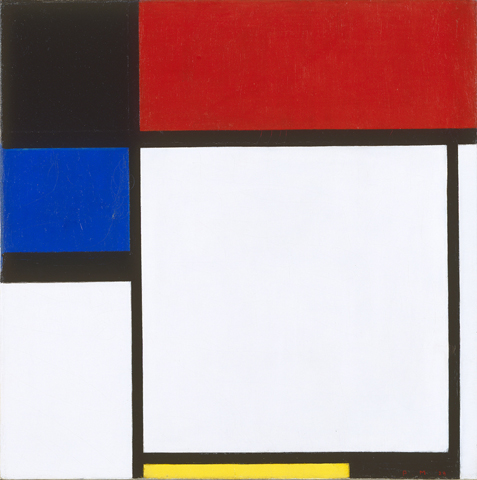
Fox Trot B. 1929."Mondrian vigorously pursued the creation of nonrepresentational art. Inspired by the metaphysical doctrines of the Theosophical Society, he believed that the appearances of nature were accidental and veiled the fundamental aspects of reality. Guided by intuition as well as theory, he carefully considered the dynamic tensions that were generated by the juxtaposition of colors within a larger, asymmetrical field. Sensitive differences in the width and length of lines also played a significant role in the relationships between these essential compositional elements. For Mondrian, the interaction of black lines with fields of white, gray, and pure, primary color embodied the intersection of the essential, creative forces that govern the universe."
At the end of 1917,Piet Mondrian’s statements about art , his quote that ” the path of ascension; away from matter,” raises some inconvenient paradoxes. If, as he said, he admired the art that is an escape from matter, how could he, at the same time, admire the modern metropolis, the greatest concentration, the very triumph of matter? The matter that Mondrian found hateful, and therefore rejected, was by no means co-extensive with all manifestations of materiality. Rather his anxiety and aversion came to fasten on the organic, the living: on the out-of-doors, and even more on the human body, with its curves, its smells, its unpredictability, its disorderly passions.
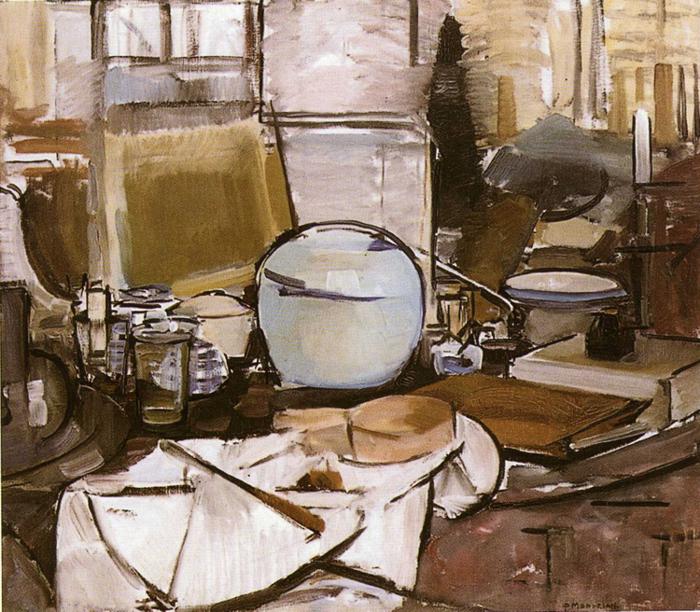
Mondrian. Still Life With Ginger Jar . 1911. A strong composition made up of easily recognizable elements; a jar, a glass, a knife, and a piece of cheese on a napkin.
Observers reported that Mondrian, sitting in café’s with friends, would ask to change places with them so that he would not have to look at trees, or at the moving shapes of passers-by. And he preferred to New York to Paris because Paris with its tree-lined boulevards was still “so romantic.” New York, it seemed, had happily shed this form of slavery to the senses. Thus, what enabled Mondrian to be a devotee of theosophy and, at the same time, of the metropolis, what made it, in fact, perfectly consistent; was that he experienced both as a concentrated, systematic assault on nature.
Absorbed as he was in his philosophical system, as contradictory and as incoherent as the cobbled and manipulated as the East meets West theories of Rudolf Steiner, Helena Blavatsky and Annie Besant might be; Mondrian was intent on evoking social and metaphysical resonances in his paintings. Mondrian at the same time envisioned his work as pure aesthetic play.
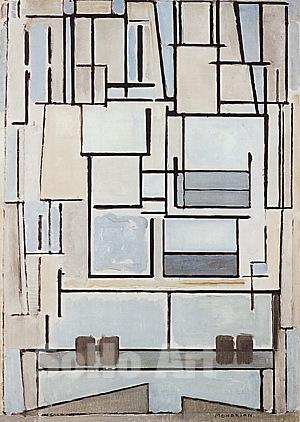
Mondrian. Blue facade. produced in Paris in 1914. A cubist version of a wall reduced to flat, geometric planes
.aWhen his friend Charmion von Wiegand protested that the colored squares he had introduced into his “Broadway Boggie-Woogie” violated his theory, Mondrian promptly and disarmingly rejoined: “But it works. You must remember, Charmion, that the paintings come first and the theory comes from the paintings.” Those privileged to watch him at work saw him revise his canvases again and again. In his American years, during World War II, he used colored tapes to find his design. As Charmon von Wiegand recalls, he would push the tapes “across the canvas until the intervals and the relations of the planes were ‘right’ … He did everything by eye. ”
For all the mathematical and rational appearance of his mature work, Mondrian made no calculations and used only the simplest tools: a ruler, strips of paper, and, in his last years, the tapes. “He often repeated,” Michel Seuphor reports, “that the rightness of proportions and relations depended on intuition alone.”

Mondrian. The C
sition in Black and White was the culmination of his so-called pier and ocean paintings.Only the hasty viewer will judge an array of Mondrian’s canvases as monotonous. In fact, he exploited the possibilities inherent in his austere, self-imposed vocabulary to the utmost: he used thick lines and thin, playing in the early 1920’s with the stubby black bands that do not quite reach the edge of his canvas; he used a small palette of primary colors, sometimes in combination, sometimes singly; he varied his designs, soetimes crowding his picture space with repeated parallels like so many prison bars, sometimes emptying it of all but a white ground barely cut by a pair of black bands; he placed a dominant square into the center of his canvas or pushed it off to one side; even the shape of his canvases-perfect squares, near squares, and, rarely, tall rectangles- was open to his restless experimentation.

"Composition" is one of Mondrian's continuing experiments with line and color. During this period he was going beyond cubism and developing a truly unique style , he lived in Holland, returning to paris in 1919 after World War I was over.
It was in the late 1920’s that Mondrian’s simplications reached their logical limit, but the development of his art did not follow a single course; sometimes he would venture into drastically different modes of expression during one year. Whatever the answers to his insistent call for pure plastic art, he found no one of them to be definitive.
Behind Mondrian’s serious, thoughtful play with lines and planes, behind his manifest philosophical purposes, there lie the deeply buried springs of his art. It is part of the historian’s conventional wisdom that he must respect intentions. This is a useful injunction. But Mondrian’s conscious intentions conceal what could be termed his unconscious intentions: impulses and purposes inaccessible to his awareness and therefore inaudible, or only faintly audible, in his correspondence, his manifestoes, and his autobiographical statements.
Inarticulate as they are about his intimate, private world, yielding up their secrets with the utmost reluctance, Mondrian’s paintings speak of an heroic effort at discipline. They speak of patience and or of self-denial. The knife-edge sharpness of the lines, the even tone and texture of the planes, reflect Mondrian’s distate for chance. In his work, deliberation is master, and this deliberation is an indispensable weapon in Mondrian’s strategy of concealment. Even the bland neutrality of his customary title “composition” , offers as little information to the interpreter as possible; the hints provided by occasional titles, like “Fox Trot A” or “Trafalgar Square” , are rare, curt and inexplicit.
What we know of the man fits his reticent paintings to perfection. When Charmion von Wiegand met him, she was forcibly struck by his “sharp ascetic features,” which she likened to those of a Catholic priest or a scientist.” It is a perceptive assessment; it characterizes a man who has given up much for the sake of utter concentration. As we know, for man, that unruly animal, asceticism is a triumph, often dearly bought, over raging inner turmoil, the firm restraining hand of Plato’s charioteer checking his willful, spirited horses of passion.

"Piet Mondrian, "Trafalgar Square," 1939-43. Oil on canvas, 57" x 47." In terms of Mondrian's late paintings, the vibrant, syncopated "Broadway Boogie Woogie" tends to dominate the the conversation, and rightly so - it would have been exceedingly interesting to see what he would have come up with if he had been able to continue on that track for a few more years (he died of pneumonia in 1944 at age 71). But while "Broadway Boogie Woogie" represented a significant departure from the typical Mondrian pictorial vocabulary, "Trafalgar Square," finished around the same time, was also a big move, even though it bears a stronger resemblance to the earlier works."
In Mondrian, to move from Plato to Freud; this restraint manifested itself in deep inhibitions and a marked obsessiveness. We do not know enough, in any event, there is nothing known about his fantasies or the details of his daily routine to venture a conclusive diagnosis. But his habits, his philosophy, and his art convincingly reinforce one another; they suggest an overriding fear, the fear of what he called “primitive animal instinct.” He was sensitive, remote, self-protective. Drawing upon the theories of Freud the release of repression of the subconscious into a fusion with the conscious was to influence Mondrian into his depictions of the “permeability” of every day life with fantasies and dreams; resulting in a plethora of aesthetics from Chagall, Magritte, Ersnt, Breton and other Mondrian contemporaries from Paris. It was an abandonment of the realm of nature and observed reality in favor of the realm of subjective creativity and picture plane reality. The artist’s canvas became a world unto itself as the work of an individual genius involved in his own causi sui project.
“According to the authors of The Spiritual in Art, Abstract Painting 1890-1985, a voluminous catalogue prepared for a show of Modern Art at the Los Angeles County Museum, the common denominator of the Modern Art hanging in prestigious galleries and museums today is the preoccupation of its producers with occult spirituality.
The catalogue’s list of artists who have dabbled in the occult is a “who’s who” of Modern Art: Jean Arp, Marcel Duchamp, Augusto Giacometti, Adolf Gotlieb, Jasper Johns, Wassily Kandinsky, Ellsworth Kelly, Paul Klee, Piet Mondrian, Eduard Munch, Barnett Newman, Georgia O’Keeffe, Jackson Pollack, Ad Reinhart, Mark Rothko, and Albert Pinkham Ryder, among a host of others. Only Pablo Picasso and Salvador Dali, considered sell-outs and successful materialists by the self appointed establishment, are missing.

"Castelbajac’s jacket (above left) is from a collection his website calls JC in the sky with diamonds!!!, a collection which also borrows Jackson Pollock’s paint drips and Disney’s Mickey Mouse for some bold Pop Art effects. Further Mondrian inspiration is in evidence on other outfits but the Dutch painter’s influence on the fashion world goes back at least as far as 1961 with a dress design by Ann Klein, followed shortly thereafter by Yves Saint Laurent’s Mondrian day dress (above right)."
The catalogue also contains an appendix of the “occult” sources of these artists: Alchemy, Kabbalah, Hermeticism, Neoplatonism, Paracelcus, Jacob Boehm, Rosicrucianism, Spiritualism, Swedenborg, Shamanism, and Theosophy, among others. Of traditional Christianity or Judaism there is no mention. The common denominator of all of these systems according to Maurice Tuchman, organizer of this exhibition and its catalogue, is that they all share the following world view:
“The universe is a single, living substance; mind and matter also are one; all things evolve in dialectical opposition; thus the universe comprises paired opposites (male-female, light-dark, vertical-horizontal, positive-negative), everything corresponds in a universal analogy, with things above as they are below; imagination is real; and self realization can come by illumination, accident, or an induced state.” ( Hamilton Reed Armstrong )
… Mondrian’s obsessive rigidity was plain to all who knew him. It manifests itself in perfectionism, a compulsive need to rework his paintings as long as they remained in his studio; the dates assigned to some of them mark periods of six or seven years. The rooms where he worked confirm his austerity; they were bare, spare, clean, as empty as possible, decorated with rectangles as though Mondrian were living in one of his own paintings. Everything was meticulously arranged as to not disturb the equilibrium of the total decor to which he sought. Clearly, his fear of disturbing this equilibrium showed a harmony and balance to be in a precarious and tenuous state; it seemed his ceremonies of neatness, of persistence, were defenses against dangerous passions bubbling beneath. …
“Mondrian wanted the infinite, and shape is finite. A straight line is infinitely extendable, and the open-ended space between two parallel straight lines is infinitely extendable. A Mondrian abstract is the most compact imaginable pictorial harmony, the most self-sufficient of painted surfaces (besides being as intimate as a Dutch interior). At the same time it stretches far beyond its borders so that it seems a fragment of a larger cosmos or so that, getting a kind of feedback from the space which it rules beyond its boundaries, it acquires a second, illusory, scale by which the distances between points on the canvas seem measurable in miles.( David Sylvester)
” ‘The positive and the negative are the causes of all action … The positive and the negative break up oneness, they are the cause of all unhappiness. The union of the positive and the negative is happiness.’ The palpable oneness of the solitary flower or tower, being subject to time and change, had to give way to the subliminal oneness of a vivid equilibrium.”
“In Man and His Symbols a book edited by Carl Jung, and one fundamental to the understanding of Modern Art, psychologist Aniela Jaffe points out a reason for this interest in the occult:
“It must be realized that what these artists, Jean Arp, Kandinsky, Klee, Mondrian etc.] were concerned with was something far greater than a problem of form and distinction between “concrete” and abstract,” figurative and non-figurative. Their goal was the center of life and things, their changeless background and an inward certitude. Art had become mysticism… Their mysticism was alien to Christianity, for that “Mercurial Spirit” is alien to the heavenly spirit. Indeed it was Christianity’s dark adversary that was forging its way in art. Here we begin to see the real historical and symbolic significance of “modern art.” Like the hermetic movements in the Middle Ages, it must be understood as a mysticism of the spirit of the earth and therefore as an expression of our time compensatory to Christianity….As has already been pointed out, the alchemists personified this spirit as “the spirit Mercurius” and called it with good reason “Mercurius Duplex” [ the two-faced, dual Mercurius ]. In the religious language of Christianity, it is called the devil. But, however improbable it may seem, the devil too has a dual aspect. In the positive sense he appears as Lucifer–literally, the light bringer.. …Looked at in the light of these difficult and paradoxical ideas, modern art [ which we have recognized as symbolic of the chthonic (earthly) spirit ] has a dual aspect. In the positive sense it is the expression of a mysteriously profound nature-mysticism; in the negative, it can only be interpreted as the expression of an evil destructive spirit. The two sides belong together, for the paradox is one of the basic qualities of the unconscious and its contents.” Jaffe goes on to quote one of the patriarchal figures of modern art, Paul Klee: “Even evil must not be a triumphant or degrading enemy, but a power collaborating in the whole.”
a
a
aa



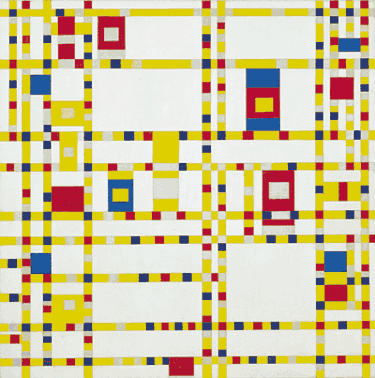
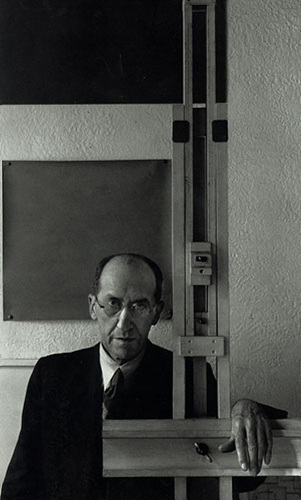



 COMMENTS
COMMENTS